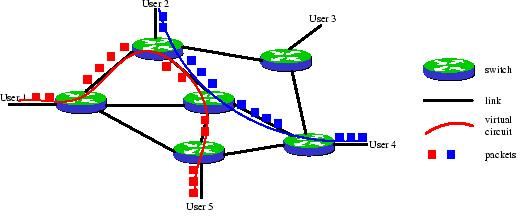Conceived in the 1960’s, packet switching is a more recent technology than circuit switching which addresses a disadvantage of circuit switching: the need to allocate resources for a circuit, thus incurring link capacity wastes when no data flows on a circuit.
Packet switching introduces the idea of cutting data on a flow into packets which are transmitted over a network without any resource being allocated. If no data is available at the sender at some point during a communication, then no packet is transmitted over the network and no resources are wasted.
 |
Figure : Datagram Packet Switching. Packets from a given flow are independent and a router can forward two packets from the same flow on two different links. |
Since each packet is processed individually by a router, all packets sent by a host to another host are not guaranteed to use the same physical links. If the routing algorithm decides to change the routing tables of the network between the instants two packets are sent, then these packets will take different paths and can even arrive out of order.
In this Figure for instance, packets use two different paths to go from User 1 to User 5. Second, on a network topology change such as a link failure, the routing protocol will automatically recompute routing tables so as to take the new topology into account and avoid the failed link. As opposed to circuit switching, no additional traffic engineering algorithm is required to reroute traffic.
Virtual circuit packet switching
 Virtual circuit packet switching (VC-switching) is a packet switching technique which merges datagram packet switching and circuit switching to extract both of their advantages. VC switching is a variation of datagram packet switching where packets flow on so-called logical circuits for which no physical resources like frequencies or time slots are allocated (see Figure).
Virtual circuit packet switching (VC-switching) is a packet switching technique which merges datagram packet switching and circuit switching to extract both of their advantages. VC switching is a variation of datagram packet switching where packets flow on so-called logical circuits for which no physical resources like frequencies or time slots are allocated (see Figure).
Each packet carries a circuit identifier, which is local to a link and updated by each switch on the path of the packet from its source to its destination. A virtual circuit is defined by the sequence of the mappings between a link taken by packets and the circuit identifier packets carry on this link. In VC-switching, routing is performed at circuit establishment time to keep packet forwarding fast.
Other advantages of VC-switching include the traffic engineering capability of circuit switching, and the resources usage efficiency of datagram packet switching. Nevertheless, a main issue of VC-Switched networks is the behavior on a topology change.
As opposed to Datagram Packet Switched networks which automatically recompute routing tables on a topology change like a link failure, in VC-switching all virtual circuits that pass through a failed link are interrupted. Hence, rerouting in VC-switching relies on traffic engineering techniques.
There are a number of important differences between virtual circuit and datagram networks. The choice strongly impacts complexity of the different types of node. Use of datagrams between intermediate nodes allows relatively simple protocols at this level, but at the expense of making the end (user) nodes more complex when end-to-end virtual circuit service is desired.
The Internet transmits datagrams between intermediate nodes using IP. Most Internet users need additional functions such as end-to-end error and sequence control to give a reliable service (equivalent to that provided by virtual circuits). This reliability may be provided by the Transmission Control Protocol (TCP), which is used end-to-end across the Internet, or by applications such as the trivial file transfer protocol (TFTP) running on top of the User Datagram Protocol (UDP)
 Dinesh Thakur holds an B.C.A, MCDBA, MCSD certifications. Dinesh authors the hugely popular
Dinesh Thakur holds an B.C.A, MCDBA, MCSD certifications. Dinesh authors the hugely popular